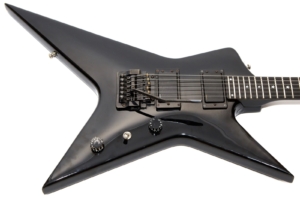 I have forever been curious about these Guild X-88 Crüe Flying Star guitars, and when the opportunity arose to grab one for a good price I jumped on it, eager to get my spandex out of storage in order to put it through its paces. The guitar I mean, not the spandex.
I have forever been curious about these Guild X-88 Crüe Flying Star guitars, and when the opportunity arose to grab one for a good price I jumped on it, eager to get my spandex out of storage in order to put it through its paces. The guitar I mean, not the spandex.
Sadly, my wife had thrown all my stretchy neon out years ago so I had to settle for a technical review devoid of any photos of me trying to reclaim my day-glo youth in style. I’m sure your disappointment is profound.
Let’s see how this, one of the pointiest of guitars of all time, holds up to the critical observations of someone who lived through the time when guitars like this were more popular in hot pink.
Introduction
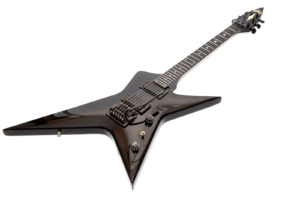 In the mid 1980s, bands like Poison and Mötley Crüe were all in the maelstrom that Wikipedia describes as the second wave of Glam Metal, though many of us who lived through that era would be quick to disagree with much of what’s in that article.
In the mid 1980s, bands like Poison and Mötley Crüe were all in the maelstrom that Wikipedia describes as the second wave of Glam Metal, though many of us who lived through that era would be quick to disagree with much of what’s in that article.
The entire scene was replete with hairspray, neon colors, men wearing makeup and woman’s lingerie over spandex, and guitars so pointy that they often distracted some of us from the fact that we were watching men wearing women’s underwear on stage while wishing we could be them. What’s crazier is that it all worked! Guys loved them, girls loved them, and the the guys loved the girls loving them. Also there was a lot of drugs.
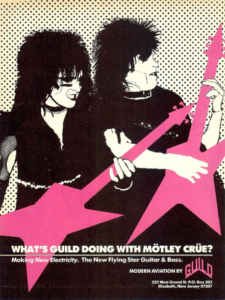 Made in 1984, this X-88 Crüe Flying Star was codesigned by Mick Mars of Mötley Crüe which led to some ads featuring Mic Mars and Nikki Six, or at least a cartoonish rendition of them playing X-88-style pink shapes. Honestly it was kind of an odd ad. I mean, why not put the actual guitar in the pictures? Maybe they couldn’t get those guys to pose for photos or something. Maybe they thought that the guitar’s shape was so amazing, so unique, and so damn pink that people would forever link “men dressed like women playing pointy pink guitars” with Guild guitars.
Made in 1984, this X-88 Crüe Flying Star was codesigned by Mick Mars of Mötley Crüe which led to some ads featuring Mic Mars and Nikki Six, or at least a cartoonish rendition of them playing X-88-style pink shapes. Honestly it was kind of an odd ad. I mean, why not put the actual guitar in the pictures? Maybe they couldn’t get those guys to pose for photos or something. Maybe they thought that the guitar’s shape was so amazing, so unique, and so damn pink that people would forever link “men dressed like women playing pointy pink guitars” with Guild guitars.
Did I mention all the drugs?
The X-88 Flying Star came stock with only one California pickup and could be ordered with a pile of options including one or two Dimarzio or EMG pickups (or single coils and humbucker, etc.), various colors, and a Kahler floating bridge. Following the price guide, the guitar in this review is technically an X-88AK3 since it’s an X-88 (duh), has two EMG humbuckers (A2), and a Kahler. The list price of this guitar would have been $990 ($660 base + $200 Kahler + $190 for two EMGs). The case (model 4580) would have been $145 and would have been worth every penny as I’ll soon explain.
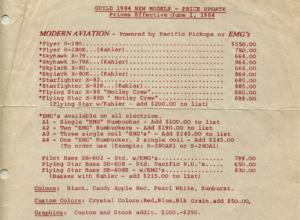 The price list for 1984 has a couple of items buried in it that make me chuckle. First, as a writer, is the fact that any time the EMG pickups are referenced, they put EMG in quotes. For example: Two “EMG” Humbuckers – Add $190.00 to list. That cracks me up because reading that I’d expect to get cheap Chinese knockoffs and not real EMGs.
The price list for 1984 has a couple of items buried in it that make me chuckle. First, as a writer, is the fact that any time the EMG pickups are referenced, they put EMG in quotes. For example: Two “EMG” Humbuckers – Add $190.00 to list. That cracks me up because reading that I’d expect to get cheap Chinese knockoffs and not real EMGs.
The second thing that cracks me up about the price list is that the X-88 is listed as the Flying Star X-88 “Motley Crew” with a notable absence of umlauts no doubt due to the lack of such features on the IBM Selectric typewriter they probably used to type the list. The kicker, and perhaps my favorite error, is the fact that it lists the X-88 model as the Motley Crew and not Motley Crue. I mean, it’s not like spell-check auto-corrected it for them. It is in quotes, though, so maybe it all makes sense.
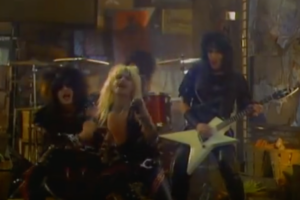 The Guild Flying Star X-88 “Motley Crew” (heh) is the same basic shape as the Guild X-82 Nova, but the X-88 Crüe has longer even sharper points, a spear-like headstock, a sort of inflated looking body, and star inlays. And Mick Mars’ blessing.
The Guild Flying Star X-88 “Motley Crew” (heh) is the same basic shape as the Guild X-82 Nova, but the X-88 Crüe has longer even sharper points, a spear-like headstock, a sort of inflated looking body, and star inlays. And Mick Mars’ blessing.
A white single-pickup version of one of these dangerously pointy guitars can be seen in the Mötley Crüe video Too Young to Fall In Love as the screen cap above shows. Oh, and if you somehow didn’t believe me about the glorious cheese-fest that was the ’80s, go watch that video. It’s got amazing martial arts sequences where four scrawny alcoholic heroin junkies defeat various kung fu warriors. No suspension of disbelief required.
And we all thought it was so cool!
The “Plug into New Electricity” flyer to the right shows three Guild X-88Ks (K for Kahler) in various colors, the most suble of which being cocaine white (I’m pretty sure that’s not the real name). The color second from the right is what I like to call, “Holy crap, were the ’80s really that crazy?” burst. The the one on the right is generally called pink. Maybe hot pink. I don’t know, the colors all kind of make me dizzy now. Oh, and the white is indeed called cocaine pearl white.
As someone who remembers 1984 (Van Halen!) with the hazy fondness of someone who also can’t seem to accept the fact that it was 33 years ago, I was very eager to wrap my hands around this bit of ’80s history and crank up the Marshalls. OK, I use an Axe-FX II XL+ for my amp needs these days, but that still works because rack-hounds first became a thing in the ’80s. Also, the only Marshall I currently own is a Class 5 and that just seemed lame even though it’s totally not.
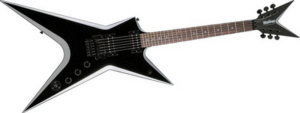 Younger players might notice that the Flying Star X-88 bears a significant resemblance to the Washburn Stealth which followed a similar design path, the shape having been designed by Dimebag Darrel of Pantera, though the Washburn Stealth was sold from 2000-200, some 15 to 20 years after Guild and Mick Mars did it first (and better, in my opinion).
Younger players might notice that the Flying Star X-88 bears a significant resemblance to the Washburn Stealth which followed a similar design path, the shape having been designed by Dimebag Darrel of Pantera, though the Washburn Stealth was sold from 2000-200, some 15 to 20 years after Guild and Mick Mars did it first (and better, in my opinion).
The Case
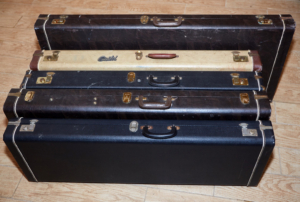 I’ve added a section here to talk about the case because holy crap, is it ever huge! It’s tall, it’s thin, it falls over, and the one I have has been border-line destroyed. Hmm… I guess it is a Mötley Crüe themed case!
I’ve added a section here to talk about the case because holy crap, is it ever huge! It’s tall, it’s thin, it falls over, and the one I have has been border-line destroyed. Hmm… I guess it is a Mötley Crüe themed case!
The pic to the right shows five guitar cases. The guitars they are holding, from front to back, are as follows: Guild S60, Guild S270, Guild S300, Guild S70, and the Guild X-88 that is the subject of this review. And yes, I have a lot of Guilds.
As you can see it’s a full four inches wider and taller than the largest of the other cases, and it’s a half inch thinner as well. All of this adds up to a case that’s likely to fall over when standing alone and because the case is to long thin and heavy, the handle flexes the entire top when used. In short, the case is a pain in the ass. The size of the case becomes a concern when buying or selling one of these guitars, too, because the case will not fit in a normal guitar box from Taylor, Gibson, or Martin, so you’ll probably end up paying more for shipping prep if you don’t do it yourself.
Now, the case by itself is one thing, but the one I got is in rough shape so I’d like to get a replacement. This guitar ain’t fitting in no Les Paul case! It doesn’t fit into any case I have, it doesn’t fit into any gig bag I have, and it really needs a case because of all those dangerous points. I will admit that it looks pretty killer hanging on the wall, though. Also, abandon all hope of this sitting on a traditional guitar stand unless you’d eventually like to see it fall on the floor.
Finish
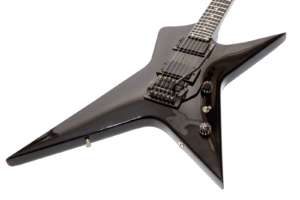 Based on the way that these ’80s Guild shredders all seem to have chips in the finish combined with the fact that I’ve never seen one with lacquer checking, I’m assuming that they’re all poly.
Based on the way that these ’80s Guild shredders all seem to have chips in the finish combined with the fact that I’ve never seen one with lacquer checking, I’m assuming that they’re all poly.
The quality of the finish is pretty good, but all of these pointy guitars are a mess at the points, and this guitar is no exception. I imagine it would be hard to protect those points, and on this guitar as you’ll soon see, it’s very long, kind of unweildy, and is prone to being smashed into everything in a three-foot radius around the player, even when the player is sober.
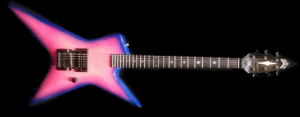 Available colors listed in the price list include the standards like white, black, candy apple red, and such, but the ones I see most often for sale are white, black, and pink. I also see that awful cotton candy burst color around pretty often, my guess being because no one wants that color these days.
Available colors listed in the price list include the standards like white, black, candy apple red, and such, but the ones I see most often for sale are white, black, and pink. I also see that awful cotton candy burst color around pretty often, my guess being because no one wants that color these days.
Fretboard and Neck
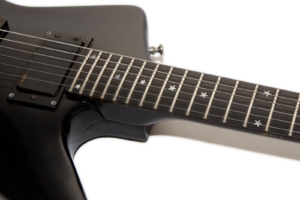 The neck is bolt-on and the scale length is short scale which for Guild means 24 3/4″.
The neck is bolt-on and the scale length is short scale which for Guild means 24 3/4″.
The fretboard is unbound ebony and the inlays are all stars, probably because the guitar is called the X-88 Flying Star and Mick Mars liked it that way. The radius of the fretboard measured at 9.5″ on my Stew Mack radius gauges. I know Mick Mars likes Strats, so it’s no surprise that the fretboard would have a very Strat-like curve to it.
The width at the nut is 1 21/32″ which is halfway between 1 5/8″ and 1 11/16″. The neck has a nice feel to it with a typical Guild medium C shape and a reasonably good depth that progresses up the fretboard as expected.
This guitar has seen some action, and the edges of the fretboard are worn and the finish seems to be either chipped away or sort of bubbling in spots, though that’s not really noticeable while playing. With its 9.5″ radius, the guitar is easy to chord and thanks to the good setup, doesn’t fret out on high notes while bending.
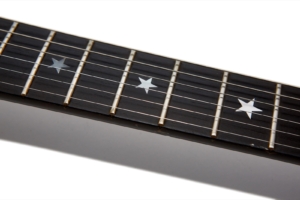 The frets measured at .115″ wide by .45″ high making them likely 6110 or 6120 jumbo frets. The neck and frets all have a pretty typical Guild feel to them and I am reminded once again of my Guild S300 which has always felt like home, though this guitar has larger frets and a slightly wider neck. The neck is also the only thing on this guitar that even remotely reminds me of that old S300.
The frets measured at .115″ wide by .45″ high making them likely 6110 or 6120 jumbo frets. The neck and frets all have a pretty typical Guild feel to them and I am reminded once again of my Guild S300 which has always felt like home, though this guitar has larger frets and a slightly wider neck. The neck is also the only thing on this guitar that even remotely reminds me of that old S300.
The neck is straight as it has been on almost every Guild electric I’ve ever owned, and as a result the action can be set nice and low or a bit higher as desired.
Build Quality
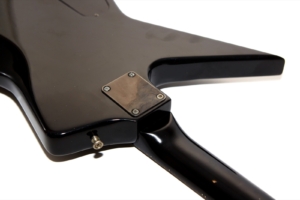 According to the Ted Beesly book, the Guild X-88 came in either mahogany or maple. I would have expected a guitar like this to be poplar, but the very edges of the pointy bits have an almost rust-like appearance to them, and while the cavities are all coated with a shielding paint, the screw holes into the wood are all dark brown which reinforces the idea that the guitar is mahogany.
According to the Ted Beesly book, the Guild X-88 came in either mahogany or maple. I would have expected a guitar like this to be poplar, but the very edges of the pointy bits have an almost rust-like appearance to them, and while the cavities are all coated with a shielding paint, the screw holes into the wood are all dark brown which reinforces the idea that the guitar is mahogany.
This guitar weighs nine pounds one ounce with the Kahler arm and battery installed which further adds credence to the body being mahogany. It also adds one more negative to the overall package; it’s not only unwieldy, it’s also fairly heavy. Because the body is so large and heavy, the center of gravity is around the pickups which means you can’t really hold the guitar by the neck joint unless it’s vertical. That’s not a deal breaker, but it seems odd especially given the balance issues while wearing a strap (more on that later).
The guitar is solid and well made and there are no feelings of “cheapness” anywhere on the guitar. The locking nut machine screws are a bit rusted but that’s common on an almost 30 year old guitar.
I’m not a big fan of bolt-on necks, but the joint is solid and I have no complaints about it. Other Guilds I’ve had with bolt-on necks use wood screws to join the two pieces, and I try not to remove necks with wood screws unless it’s absolutely necessary since I think it’s a bad idea to disturb the thread channels in the wood. For that reason I left this one alone.
Pickups
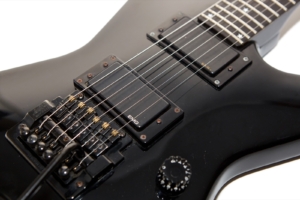 The pickups in this guitar are EMG humbuckers with a model 85 in the neck and a model 81 in the bridge. The pickups are both powered by a 9V battery (see the next section for details).
The pickups in this guitar are EMG humbuckers with a model 85 in the neck and a model 81 in the bridge. The pickups are both powered by a 9V battery (see the next section for details).
I was never a fan of EMGs until recently. When I started writing these reviews I had my Axe-FX system that let me sample many amp types, and that allowed me to appreciate the EMGs in a way that I couldn’t previously. Although I’m still not a fan of having batteries in guitars, especially when there isn’t a dedicated battery compartment, I think the EMGs are great for high-gain situations where power and articulation is more important than character.
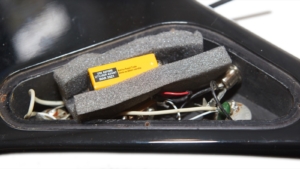 The downside to the EMGs in this guitar is the fact that the battery is in the control cavity. As you’ll discover as the review progresses, there are some aspects of this guitar that I don’t like, and this is one of them. I think perhaps the guitar was not designed around the EMG whereas a guitar like the S284 was, so the battery crammed into the control cavity is a bit of an afterthought. Really, though, the problem is that the cover needs to be removed to change the battery and that leads to chipped or broken covers (which this guitar has) and/or lost and hopefully replaced cover screws (which this guitar also has). Most importantly, ham-fisted guitarists may end up stripping the screw holes or as I found on an S100 I used to own, break the screw head off leaving the screw shaft in the wood.
The downside to the EMGs in this guitar is the fact that the battery is in the control cavity. As you’ll discover as the review progresses, there are some aspects of this guitar that I don’t like, and this is one of them. I think perhaps the guitar was not designed around the EMG whereas a guitar like the S284 was, so the battery crammed into the control cavity is a bit of an afterthought. Really, though, the problem is that the cover needs to be removed to change the battery and that leads to chipped or broken covers (which this guitar has) and/or lost and hopefully replaced cover screws (which this guitar also has). Most importantly, ham-fisted guitarists may end up stripping the screw holes or as I found on an S100 I used to own, break the screw head off leaving the screw shaft in the wood.
Electronics
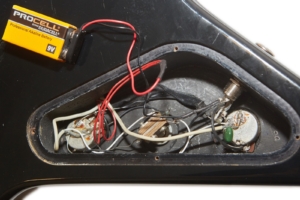 The electronics are comprised of two 25K Ω pots which are the standard values for EMG pickup installations, a standard pickup selector toggle switch, the stereo output jack, and a 9V battery. The jack is stereo so that the mono guitar cable will short sleeve and ring on the jack and close the circuit. In other words, if you want to preserve your battery life, unplug the guitar between sets.
The electronics are comprised of two 25K Ω pots which are the standard values for EMG pickup installations, a standard pickup selector toggle switch, the stereo output jack, and a 9V battery. The jack is stereo so that the mono guitar cable will short sleeve and ring on the jack and close the circuit. In other words, if you want to preserve your battery life, unplug the guitar between sets.
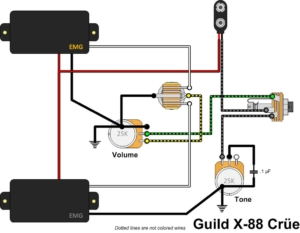 The wiring is interesting for a couple of reasons. First, the “hot” signal lead never touches the tone pot. The tone pot is completely contained on the ground side of the circuit.
The wiring is interesting for a couple of reasons. First, the “hot” signal lead never touches the tone pot. The tone pot is completely contained on the ground side of the circuit.
Secondly, each pickup is grounded to one of the pots. I don’t think this is particularly important, but if you look the signal wire from each of the pickups goes directly to the pickup selector switch. Normally I see the pickups go to the volume pots and then to the selector switch, but because this is a master tone/volume setup, the pots are after the selector switch in the circuit.
None of these variations really matter from the AC circuit standpoint, but they’re different than what I normally see when I tear open a guitar so I figured pointing them out might help someone trying to restore one of these guitars to the original design.
Hardware
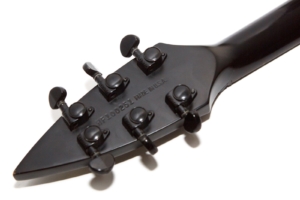 The tuners are Black grover Rotomatics and function well, though the strings are locked down on this guitar by the Kahler’s locking nut so once the guitar is tuned up they have little to do with the guitars tuning stability (non-Kahler models would of course differ).
The tuners are Black grover Rotomatics and function well, though the strings are locked down on this guitar by the Kahler’s locking nut so once the guitar is tuned up they have little to do with the guitars tuning stability (non-Kahler models would of course differ).
The Kahler is the same 2300 Pro model found on most of the ’80s Guild shredders I’ve reviewed. It functions quite well with the only downside being the infuriating locking nut and the tendency for the fine tuning knobs to turn while palm muting.
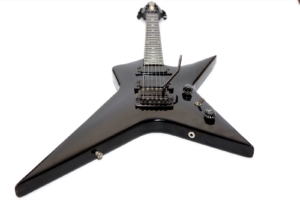 The strap pegs are nothing special, but they are mounted kind of oddly which I’ll go over in the playability section.
The strap pegs are nothing special, but they are mounted kind of oddly which I’ll go over in the playability section.
The knobs on this guitar are Guild speed knobs, and they may very well be original, though I’d have preferred the knurled metal knobs found on other Guild shredders.
The switch tip is the fantastic Guild metal switch tip that can be all but impossible to replace, so that was a nice surprise because given the wear on the case I would have expected the switch tip to be long lost by now.
With the exception of the placement of the strap pegs, the hardware is pretty standard for a Guild from 1984.
Sound
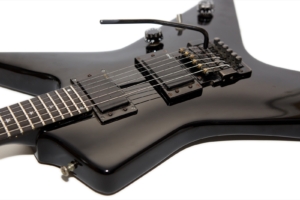 After reviewing a lot of guitars, you come to realize that a lot of them sound the same. It can be hard to distinguish three dual-humbucker guitars when they all have the same hardware and the same EMG 85+81 setup. Certainly tonal variations exist when the wood type, fretboard (don’t get me started), neck, and mass of the guitar changes, but at high gain I think most if not all of those nuances are lost. I think this is part of what causes people to proclaim that EMG pickups sound “sterile” or “hi-fi” because we’ve spent lifetimes chasing the subtle character differences in analog pickups and there’s none of that in the EMG system when all the guitars use the same model pickups.
After reviewing a lot of guitars, you come to realize that a lot of them sound the same. It can be hard to distinguish three dual-humbucker guitars when they all have the same hardware and the same EMG 85+81 setup. Certainly tonal variations exist when the wood type, fretboard (don’t get me started), neck, and mass of the guitar changes, but at high gain I think most if not all of those nuances are lost. I think this is part of what causes people to proclaim that EMG pickups sound “sterile” or “hi-fi” because we’ve spent lifetimes chasing the subtle character differences in analog pickups and there’s none of that in the EMG system when all the guitars use the same model pickups.
Too Young
Looks Could Kill
Kick Start
[/dropshadowbox]For this guitar I did not go through my normal clean/distorted/cycle through all the pickups routine because I seriously doubt that someone would buy one of these for comping 7th chords in a jazz band. Instead, I just plugged it in and let ‘er rip. Note that the guitar is tuned down a whole step for all three recordings.
The setup for these recordings is my Axe-FX II XL+ direct into my Macbook Pro via USB. Thankfully, I’ve figured out all the drops issues (CPU utilization both on the AXE-FX and the Mac) and now get some pretty clean recordings.
The recordings are my terrible renditions of Too Young to Fall in Love, followed by If Looks Could Kill, and finally followed up by Kick Start my Heart. The amps settings on the first two are a Mötley Crüe custom patch that I download from the Fractal Axe-Change site. The last one is a default patch called “Thick and Chunky” which is basically a vintage Mesa Recto-Verb. All three recordings are the bridge pickup.
Playability
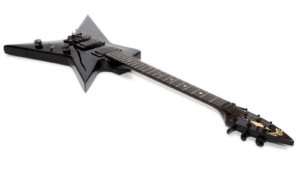 This guitar play great while seated, though if you’re on a stool or spinning chair beware of the huge pointy spike on the back of the guitar because it probably sticks out farther than you think it does. Similarly, the headstock is longer than you think it is and you’ll probably smash it into something eventually.
This guitar play great while seated, though if you’re on a stool or spinning chair beware of the huge pointy spike on the back of the guitar because it probably sticks out farther than you think it does. Similarly, the headstock is longer than you think it is and you’ll probably smash it into something eventually.
I love goofy pointy ’80s guitars, but even I have to admit that this guitar is kind of ridiculous. Why? First off, it hangs funny when standing. The guitar swings from the strap due to its shape and because both of the strap pegs are above the centerline of the guitar. That means that the guitar kind of swings like a pendulum which is exacerbated when using the Kahler.
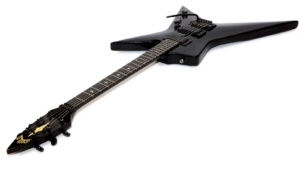 Because of the way the strap pegs are set, it also hangs lower than other guitars given the same strap length. If I were to keep one of these in rotation it would need its own strap dedicated to the guitar. That’s not the end of the world, but it’s worth pointing out that this guitar does not behave like any other guitar I’ve owned or played. If you look at that Washburn Stealth I talked about in the introduction, you’ll see that it has the exact same strap peg placement so this is not the only guitar out there with this issue.
Because of the way the strap pegs are set, it also hangs lower than other guitars given the same strap length. If I were to keep one of these in rotation it would need its own strap dedicated to the guitar. That’s not the end of the world, but it’s worth pointing out that this guitar does not behave like any other guitar I’ve owned or played. If you look at that Washburn Stealth I talked about in the introduction, you’ll see that it has the exact same strap peg placement so this is not the only guitar out there with this issue.
The X-88 is slightly neck-heavy enough that when I play with one of my smooth El Dorado straps the guitar will slide on my shoulder and do the headstock dive thing. I learned to lean my elbow on the giant tail-fin on the back which counter-balanced the guitar. A more abrasive strap would probably keep it more steady, but it would not solve the problem of the guitar swinging due to the strap pegs being so high above the midline of the instrument. I find this odd because of the fact that when being held by the neck joint, the guitar appears to be very body-heavy.
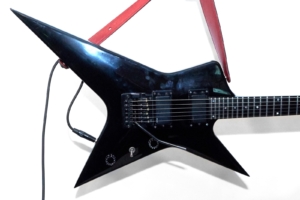 With the output jack on the inside of the bottom spike, the cord sticks out from an odd angle, and tucking it into the strap like most gigging musicians generally do makes it look weird – almost like that Ibanez Destroyer that Eddie Van Halen ruined (his words, not mine) by cutting parts out and adding those turnbuckles on the back. That guitar is known as the shark, and it actually bears a bit of a resemblance to the shape of this X-88 Flying Star, though I doubt it attracts fingerprints like this pointy black monster does.
With the output jack on the inside of the bottom spike, the cord sticks out from an odd angle, and tucking it into the strap like most gigging musicians generally do makes it look weird – almost like that Ibanez Destroyer that Eddie Van Halen ruined (his words, not mine) by cutting parts out and adding those turnbuckles on the back. That guitar is known as the shark, and it actually bears a bit of a resemblance to the shape of this X-88 Flying Star, though I doubt it attracts fingerprints like this pointy black monster does.
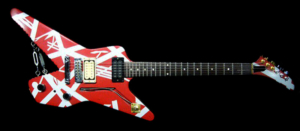 I think this guitar would play a lot better without the Kahler, but the Kahler is kind of part of the appeal. When using and abusing a floating trem, you need a stable platform and the way this guitar hangs just doesn’t lend itself to whammy abuse.
I think this guitar would play a lot better without the Kahler, but the Kahler is kind of part of the appeal. When using and abusing a floating trem, you need a stable platform and the way this guitar hangs just doesn’t lend itself to whammy abuse.
Conclusion
I really like this guitar. On paper.
In practice, though, the guitar is kind of a pain in the ass. It’s huge, it’s heavy (but not Norlin-era Les Paul Custom heavy), the giant point on the back slams into things all the time, the long pointy headstock slams into things all the time, it swings like a pendulum on a strap, the neck feels like it’s a mile long, and the swinging pendulum thing makes the Kahler more difficult to use. Oh yeah, and the case sucks and is practically impossible to replace.
However…
This guitar is fun. When you strap it on you feel like ripping into some fingertapping hair metal and you feel like making it loud. The problem is that it’s fun for a while, kind of like playing with a two year old; they’re fun to play with until they’re not at which point I want to hand it back to the owner because I just remembered that I’m not 25 anymore.
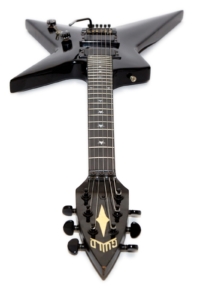 As much as I loved the ’80s, I can’t really recommend this guitar as an only guitar, and that’s a rarity for me when it comes to Guilds. Sure, it’s fun, and it definitely nails the intended vibe, but If I’m going to do the ’80s thing I’ll grab a guitar that delivers without being such a pain in the ass. If I want the crazy ’80s vibe I’ll grab the much smaller Guild X-79 or even better, my Guild X-80. If you’re looking for an addition to your stable of guitars and you have the room for the ridiculously large case, then this guitar will provide years of fun.
As much as I loved the ’80s, I can’t really recommend this guitar as an only guitar, and that’s a rarity for me when it comes to Guilds. Sure, it’s fun, and it definitely nails the intended vibe, but If I’m going to do the ’80s thing I’ll grab a guitar that delivers without being such a pain in the ass. If I want the crazy ’80s vibe I’ll grab the much smaller Guild X-79 or even better, my Guild X-80. If you’re looking for an addition to your stable of guitars and you have the room for the ridiculously large case, then this guitar will provide years of fun.
Having written that, the guitar is currently hanging on my office wall because it’s so unique. It is most definitely an attention grabber and conversation starter and people who aren’t even into guitars ask me about it. Oh, and don’t worry, I play my wall hangers and I can prove it by the dent in my ceiling that the pointy headstock put there from taking it down repeatedly.
Of course, if you know anything about Mötley Crüe then you know their whole schtick was being over the top in every way. If that’s your thing, then this is the guitar for you and nothing I could write would matter, anyway.
Donate: PayPal Crypto:
ETH: 0x0AC57f8e0A49dc06Ed4f7926d169342ec4FCd461
Doge: DFWpLqMr6QF67t4wRzvTtNd8UDwjGTQBGs
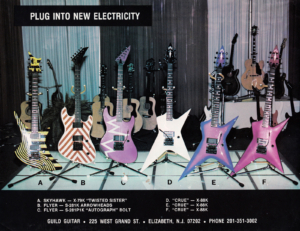

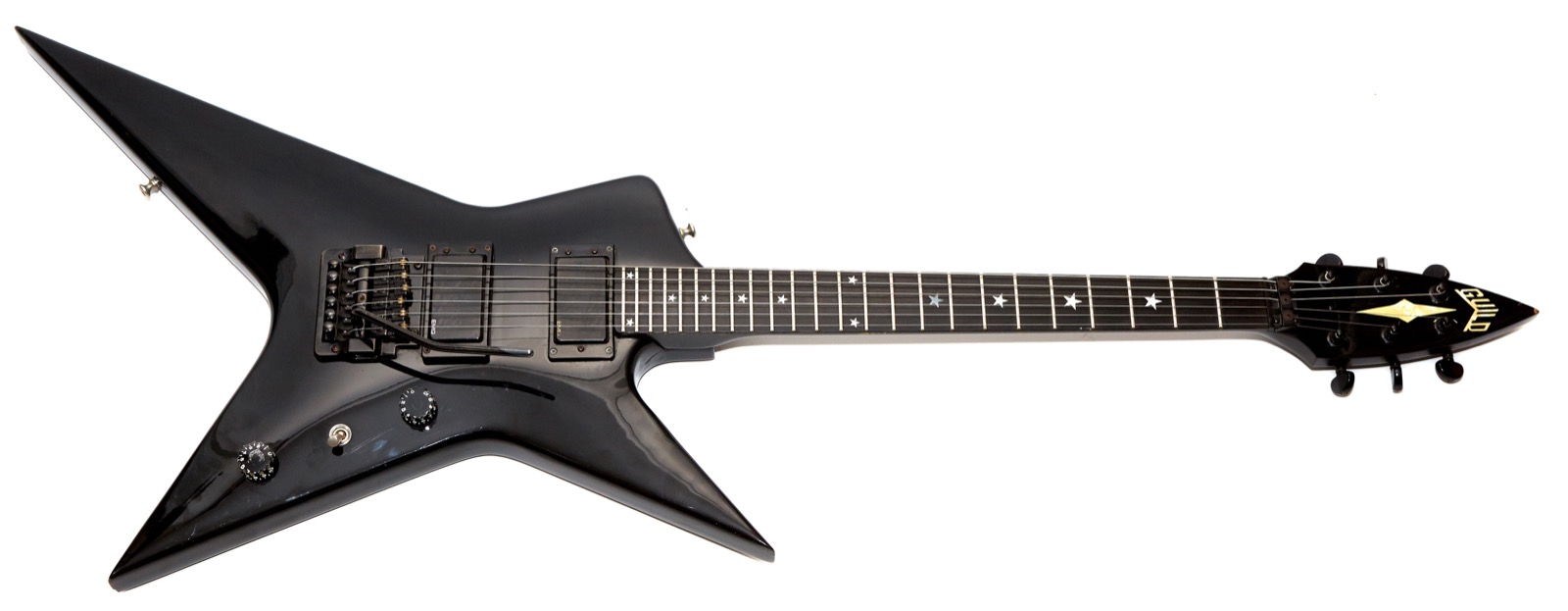
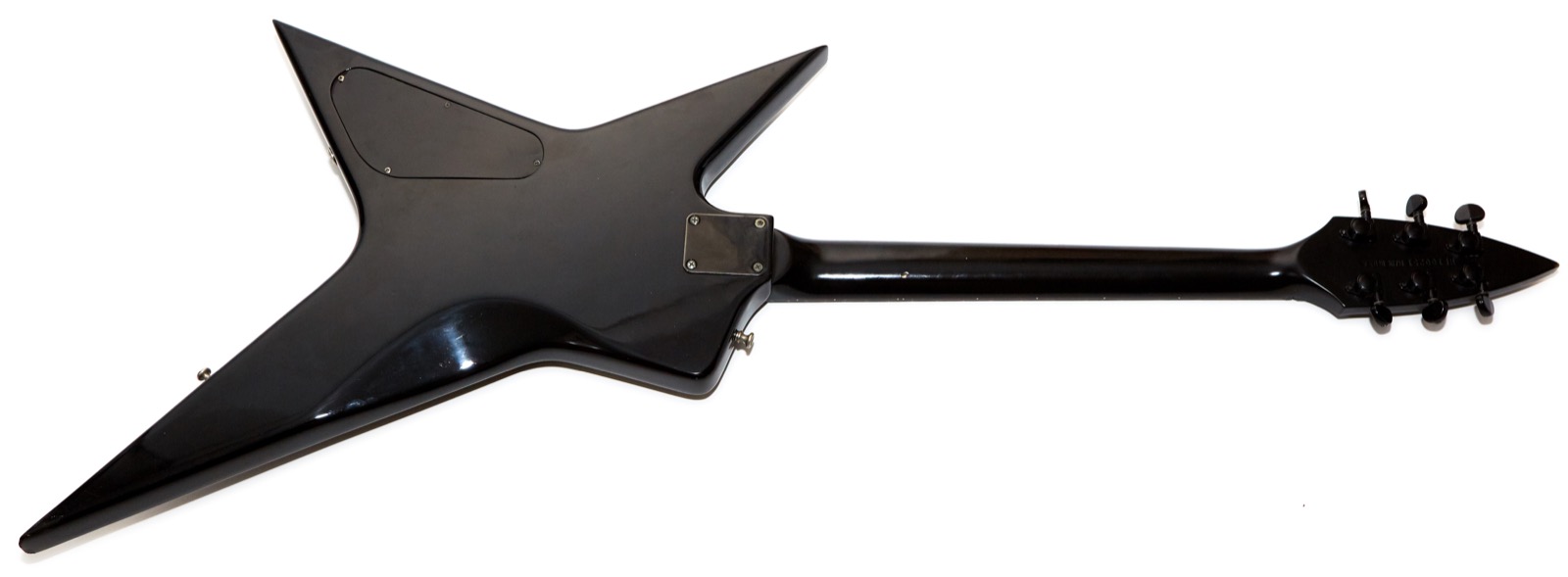
Hey, hows it going? I just got the hot pink x88 with the black kahler and active emg! Theres not a scratch on it! A [girl] had it and kept it in the case for many years! I think the original strings were on ot because they were black and corroted! Anyway it plays like butter and ot sounds killer through the marshall!! This gpes great with my collecton of the old bc rich bich and mockingbird!
By the way, how many of the hot pink ones were made?
Hot pink are the most common. No one wanted them then and no one really wants hot pink now. Thus they are cheaper. The black and white are less common and get more money. Usually they are chipping at the points. Those that arent get more money.
I have a black single pickup model in immaculate condition I have owned for about 20 years now ,this thing screams /I dont play it much as the strat is a bit more comfy
Hi. I want to let you know that I have a case for sale on EBay. In your write-up, you mentioned that you would like a new case. Anyhow, just want to make you aware.
Mark
Here’s a link
https://rover.ebay.com/rover/0/0/0?mpre=https%3A%2F%2Fwww.ebay.com%2Fulk%2Fitm%2F153189984620
Thanks. Sold the guitar a while back and managed to find the buyer a new case as well about six months back. Yours would have been a most welcome post if not for the passage of time. Hopefully this will help someone else find one as they are not easy to find.
I recently added one of these to my collection. It has the inline 6 headstock. I’ve read that this would mean it was made in ‘85. The white, pink and black ones have been the only ones I’ve seen online. Mine is blue. Do you have any idea how many blue ones were made?
Sorry no idea. I’d love to see pics, though.
I bought an X88 back in 1984-85? It was about 750.00 I believe. Wish I still had it. It was black/white zebra striped from the factory, and no one seems to recall them ever being made in that color scheme. Had the Kahler and two humbuckers. I’ve been searching for years to see if it still exists and would love it acquire it back, as it was my first real guitar as a teen and has sentiment. I had regrettedly traded it in for some other gear around 1987-88 or so at East Coast Music in Danbury, CT if anyone knows of it’s whereabouts. Clearviewmusic@aol.com
I have a white X88D with a Kahler and 2 Dimarzio humbuckers. Bought it new in 1984 for $750 at The Music Nook in Milford MA. Minor knicks on tips. I didnt even have a drivers license at the time so had to take a cab to go buy it! I wonder how much it’s worth now..